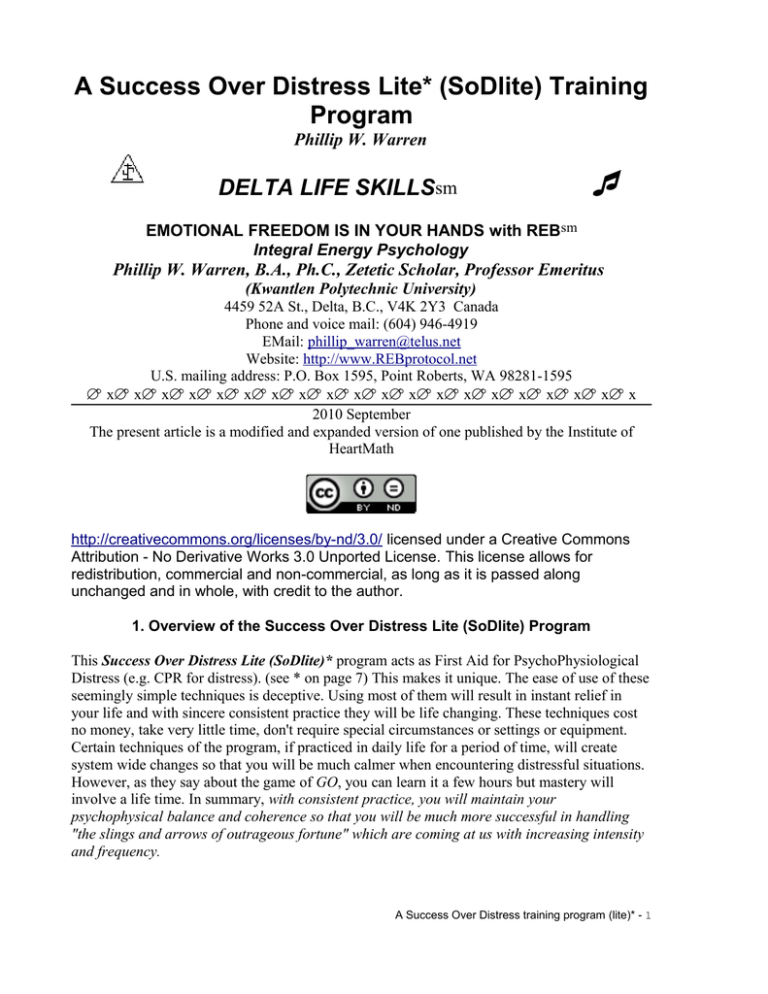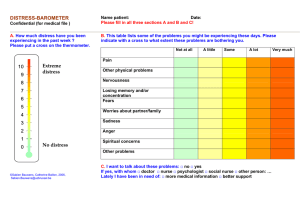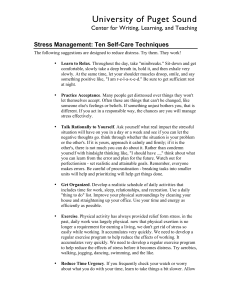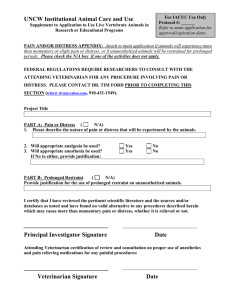¯ A Success Over Distress Lite* (SoDlite) Training Program DELTA LIFE SKILLS
advertisement

A Success Over Distress Lite* (SoDlite) Training Program Phillip W. Warren DELTA LIFE SKILLSsm ¯ EMOTIONAL FREEDOM IS IN YOUR HANDS with REBsm Integral Energy Psychology Phillip W. Warren, B.A., Ph.C., Zetetic Scholar, Professor Emeritus (Kwantlen Polytechnic University) 4459 52A St., Delta, B.C., V4K 2Y3 Canada Phone and voice mail: (604) 946-4919 EMail: phillip_warren@telus.net Website: http://www.REBprotocol.net U.S. mailing address: P.O. Box 1595, Point Roberts, WA 98281-1595 ∆∞x∆∞x∆∞x∆∞x∆∞x∆∞x∆∞x∆∞x∆∞x∆∞x∆∞x∆∞x∆∞x∆∞x∆∞x∆∞x∆∞x∆∞x∆∞x∆∞x 2010 September The present article is a modified and expanded version of one published by the Institute of HeartMath http://creativecommons.org/licenses/by-nd/3.0/ licensed under a Creative Commons Attribution - No Derivative Works 3.0 Unported License. This license allows for redistribution, commercial and non-commercial, as long as it is passed along unchanged and in whole, with credit to the author. 1. Overview of the Success Over Distress Lite (SoDlite) Program This Success Over Distress Lite (SoDlite)* program acts as First Aid for PsychoPhysiological Distress (e.g. CPR for distress). (see * on page 7) This makes it unique. The ease of use of these seemingly simple techniques is deceptive. Using most of them will result in instant relief in your life and with sincere consistent practice they will be life changing. These techniques cost no money, take very little time, don't require special circumstances or settings or equipment. Certain techniques of the program, if practiced in daily life for a period of time, will create system wide changes so that you will be much calmer when encountering distressful situations. However, as they say about the game of GO, you can learn it a few hours but mastery will involve a life time. In summary, with consistent practice, you will maintain your psychophysical balance and coherence so that you will be much more successful in handling "the slings and arrows of outrageous fortune" which are coming at us with increasing intensity and frequency. A Success Over Distress training program (lite)* - 1 Success Over Distress Lite (SoDlite) program incorporates several cutting edge methods For some time, I've been researching the most powerful and simplest do-it-yourself approaches for de-stressing. An brief overview of my research is contained in this document: A Success Over Distress (lite) training program 10 pages (as well as on my website http:www.REBprotocol.net ). The manual of the actual methods is contained in the document : Simple fast and immediate stress management and reduction techniques (lite) 18 pages. The methods contained in the manual, which I also use in one to one life coaching, involve these powerful approaches, incorporated in a compact and user friendly package: From meditation traditions: Breathing through the nose and a nonattachment/mindfulness/just noticing perspective to life. From cognitive behavioural therapy and Neural Linguistic Programming (NLP) approaches: Effective affirmations and self talk monitoring (avoiding the "Yea Buts" and self-sabotage), changing the internal image of an issue and using eye positions and eye movements to discover hidden aspects of an issue. From Energy Psychology, Traditional Chinese and other Asian healing traditions: Stimulating and engaging the meridians, accupoints and chakras. From Positive Psychology, HeartMath and HRV (Heart Rate Variability) research: Bringing positive feelings to the heart, your major electromagnetic bio-driver. A coherent heart (optimal HRV) results in a coherent and integrated system (body, mind, spirit). From Somatic, Trauma and Focusing ("Felt Sense") psychotherapy approaches: Identifying where in your body you are storing the effects of your issues ("The body keeps the score"). What happened to you is not the target. The important thing and critical target is how you are holding on to the past and the effects it has on you in present time. 2. Limitations of Many Stress Management Approaches There exist many stress-reduction approaches and techniques for handling distress which have been implemented over the years to help people cope with increased stress. They typically involve long term commitments as well as changing ones lifestyle (e.g., diet and nutritional education programs, exercise and fitness programs, yoga, tai chi/Qi Gong, relaxation A Success Over Distress training program (lite)* - 2 and meditation, communing with nature/gardening, time management and goal setting techniques, bathing using bicarbonate of soda and food grade H2O2, listening to healing music, etc). Many businesses as well as miscellaneous wellness sources recommend these. Although some benefits have been realized from these programs when actually engaged in, most have not resulted in the desired outcomes, and the level of stress experienced by the general public and workers has continued to rise. One contributing factor to this lack of success in distress response reduction involves the fact that the programs take time to show results and require effort and commitment. For the general public this requires taking the time, making the effort and spending the money to implement the program. For employees, even when the business supports these programs with free memberships and counseling or on site facilities, the time and effort needed to take advantage often leads to their eventual lack of success. Thus, typically, individuals will began a potentially helpful program but soon slack off or quite altogether. As a result of this limitation, the proportion of workers who reported feeling "highly stressed," for example, more than doubled from 1985 to 1990. This happened even though the above stress-reductions approaches were available. Alarmingly, more recent surveys reveal that workplace stress has driven a significant proportion of adults to cry, yell at coworkers, lose sleep, consume alcohol, damage workplace equipment or furniture, call in sick, and even quit their jobs. Increasing eruptions of hostile, explosive and violent behavior in the workplace, recently described as "desk rage," reflect a fundamental level of emotional turmoil among workers that remains unresolved. In addition, the workplace is not the only situation where this type of reaction is increasing on a daily basis. It's becoming more and more common in all walks of life. "The main limitation of most stress-reduction approaches now in use in the workplace is that they do not provide a means to reduce or avoid stress in the moment, as it occurs." Doc Childre While situations, encounters or events may seem intrinsically "stressful," it is truly how people perceive and react to an event that determines whether or not the stress response is activated. The main limitation of most stress-reduction approaches now in use is that while helpful, they do not target the real source of people's stress, enabling them to transform their perceptions and reactions to potentially "stressful" situations in the moment they occur. A Success Over Distress training program (lite)* - 3 3. A Basic Success Over Distress Lite (SoDlite)* Training Program for Enhancing Human Performance, Organizational Effectiveness and Creating a More Peaceful Life As stated above, this Success Over Distress Lite (SoDlite)* program is First Aid for PsychoPhysiological Distress (eg. CPR). The advice "Don't let it get to you", while sound, doesn't provide guidance as to how specifically you might implement it. The Success Over Distress Lite (SoDlite)* program provides you with a number of approaches to put this good advise into practice. The techniques taught can be used immediately, in vivo, rather than waiting for a better time and place to "calm down and collect yourself." Distress does throw you off balance, causing you to loose focus and coherence. When this happens, you can't generate creative and practical options for handling the distress. Thus the title Success Over Distress Lite (SoDlite)* refers to the abbreviated version of the 16 hour complete program developed by Dr. Wayne Topping (see * on page 6). Many businesses have been focusing on reengineering their organizations to enhance productivity and the bottom line. Any effort to unleash the full power of an organization will have to start with empowering the individual. When individuals are internally self-managed, they operate at their greatest potential, enabling the organization to maximize its productivity and quality. The tools and techniques given in this Success Over Distress Lite (SoDlite)* training program are designed for practical use in the midst of life's fast-paced situations and often unpredictable stresses. Their fundamental purpose -- to enable people to transform draining reactions and function with maximum effectiveness in the moment -- makes them ideally suited for the practical settings of the workplace and everyday encounters. This is where, as the statistics have shown, they are most needed. This Success Over Distress Lite (SoDlite)* training program enables people to bring the increased coherence associated with bio-energetic heartfocused management of the mind and emotions into the practical setting of the workplace as well as life in general (see the "Addendum: Heart Intelligence"). A Success Over Distress Lite (SoDlite)* training program can be specifically tailored to the needs of individuals and of businesses and organizations. The proposed Success Over Distress Lite (SoDlite)* training program provides a set of techniques that can be used immediately in all life situations, work A Success Over Distress training program (lite)* - 4 and otherwise. "Flexibility and adaptability do not happen just by reacting fast to new information. They arise from mental and emotional balance,the lack of attachment to specific outcomes,and putting care for self and others as a prime operating physiology. Flexible physiology means more resilience in times of challenge or strain. Staying open -- emotionally -- insures internal flexibility." Doc Childre & Bruce Cryer (2000) 4. From Chaos to Coherence People as well as companies have discovered that the information age requires a new type of intelligence for people to sort through, filter and effectively process an incredible flow of information. The physiological incoherence created by unmanaged reactions to stress may actually inhibit brain function, reducing us to extremely limited perspectives. Sadly, many people have adapted so thoroughly to the stressful conditions around them that they hardly realize just how limited their perspectives actually are. The basic premise of this Success Over Distress Lite (SoDlite)* training program is that as individuals learn to maintain a coherent internal environment through mental/emotional management, the heart and brain synchronize, and a synergy of intellectual, intuitive and emotional intelligence takes place. This expands our perspectives, allowing us to transform stressful reactions into healthy responses and effective solutions. It becomes quickly obvious that the benefits extend far beyond stress reduction. Studies with major organizations have revealed that the these Success Over Distress Lite (SoDlite)* tools, sincerely practiced, allow individuals to maximize their personal balance, physical health, intelligence and performance. These benefits, extended to the organization, lead to enhanced interpersonal communication and team dynamics, more effective creative and intuitive problem solving, improved planning and decision making, greater care for customers and coworkers, and over-all increased actualization of the organization's full potential. Life just works better and becomes much more enjoyable. "Living from the heart is business — the business of caring for self and others. Understanding this will take us past the age of information into the age of intuitive living." Doc Childre (see the "Addendum: Heart Intelligence") A Success Over Distress training program (lite)* - 5 Research demonstrates the profound impact that Success Over Distress Lite (SoDlite)* training in these techniques has had on employees of diverse organizations as well as the general public. Major improvements in the company became apparent in some cases after only six weeks' practice of the tools learned. The Success Over Distress Lite (SoDlite)* trainings were highly effective in workers at all levels of employment, and proved instrumental in helping several organizations move through particularly difficult circumstances and stressful transitions with increased facility and minimized energy drain. Results indicate that practice of the Success Over Distress Lite (SoDlite)* techniques has not only significantly improved employees' emotional balance and attitudes but has also affected their physical health, resulting in improved autonomic function, increased vitality and reductions in a variety of physical symptoms of stress (including sleeplessness, body aches, indigestion and rapid heartbeats). Notably, case studies show that hypertensive employees who used the Success Over Distress Lite (SoDlite)* interventions were able to restore blood pressure levels to normal values without the aid of medication. Furthermore, the Success Over Distress Lite (SoDlite)* techniques have enabled employees to significantly increase their productivity, mental clarity, creativity and enjoyment of their work, improvements that profoundly impact overall workplace quality and effectiveness. 5. An example of research using a Success Over Distress training program: HeartMath's Inner Quality Management (IQM) Barrios-Choplin, Bob, Rollin McCraty, and Bruce Cryer, (1997) "An Inner Quality approach to reducing stress and improving physical and emotional well-being at work," Stress Medicine; 13 (3): 193-201. Key findings: Motorola employees trained in the Inner Quality Management (IQM) Success Over Distress techniques experienced increased contentment, job satisfaction and communication and decreased tension, anxiety, nervousness and physical symptoms of stress six months after the Success Over Distress training program. Blood pressure in hypertensive individuals was restored to normal levels and there were overall improvements in autonomic activity. Summary: This exploratory field study examined the impact of the Inner Quality Management (IQM) Success Over Distress training program on a sample of Motorola managers, engineers and factory workers. Both psychological and physiological measures were assessed. Emotional stressors and social attitudes, physical symptoms of stress and workplace effectiveness were measured by a survey conducted prior to, and three and six months following the Success Over Distress training program. Autonomic activity, measured by short-term heart rate variability analysis, and blood pressure were also assessed before the Success Over Distress training and again six months afterwards. Results showed that caring, contentment, job satisfaction and communication significantly increased after this Success Over Distress training program, while tension, nervousness, anxiety and physical symptoms of stress significantly decreased. Of the 18 managers and engineers whose blood pressure was measured, five were classified as stage 1 or stage 2 hypertensive prior to the training. The number of participants with hypertension equaled 28% of the sample, A Success Over Distress training program (lite)* - 6 which corresponds to the national average of 28% of the population with this disorder. None of these individuals were being treated by a doctor or taking any medications to control their hypertension. The present article is a modified and expanded version of one published by the Institute of HeartMath. HeartMath LLC ( http://www.heartmath.com ) is a cutting-edge performance company providing a range of unique services, products, and technology to improve health and well-being, while dramatically reducing stress and boosting performance and productivity. For more than 17 years HeartMath clinical studies have demonstrated the critical link between emotions, heart function, and cognitive performance. HeartMath's compelling solutions for stress relief have been published in numerous peer-reviewed journals such as American Journal of Cardiology, Stress Medicine, Preventive Cardiology, Journal of the American College of Cardiology, Integrative Physiological and Behavioral Science and Alternative Therapies in Health and Medicine. HeartMath’s organizational clients include Duke Medicine, Stanford Business School, Stanford Hospital, Mayo Health System, Blue Cross Blue Shield, Sutter Health, Scripps Center for Integrative Medicine, BP, Cisco Systems, Redken, Kaiser Permanente, Boeing and the NASA Goddard Space Flight Center, as well as dozens of school systems and thousands of health professionals around the world. * Success Over Distress Lite (SoDlite)* workshop manual is an abbreviated version of Dr. Wayne Topping's two day (16 hour) course and 1990 book Success over Distress: Using muscle testing to help you master your fears, to expand your awareness, and reach your full potential, Topping International Institute, Bellingham, WA USA, 98225. The "lite*" version/manual includes added techniques from Mindfulness meditation, HeartMath and Delta Life Skills' Radiant Energies Balance (REB) Protocol. Don't let the designation (lite)* fool you. This briefer version of the course provides powerful and efficient techniques which, if put into practice, will create profound improvements in ones daily living and performance. As stated above with consistent practice, you will maintain your psychophysical balance and coherence so that you will be much more successful in handling "the slings and arrows of outrageous fortune" which are coming at us with increasing intensity and frequency. Basic training where students learn the mechanics of the movements and postures (without background explanation and rationale) of the "lite*" version lasts about 3 to 6 hours. More complete explanations and follow up consultation and reinforcement TBD. Success Over Distress -SoDlite* workshop manual provided: "Simple, fast and immediate stress reduction and management (lite)." Success Over Distress Lite (SoDlite)* menu of techniques ("Buffet" of destressors): The techniques ("Buffet" of destressors): 1. Daily System Maintenance Activities 1.a. Drink some water, a major destressor and bodymind integrator 1.b. Touch the tip of your tongue to the roof of your mouth just behind the teeth 1.c. Yawn and stretch 1.d. Assume a positive physical posture Do deep abdominal breathing through the NOSE (see description in section 7a. A Success Over Distress training program (lite)* - 7 below) 2. # Psychoenergetic Reversal Correction 3. #"Quick Fix": A 3D Electromagnetic Balance 4. # Bodymind Control Centers Balance 5. # Cross Crawl 6.a. Hold the Stress Release Points (SRP) and Frontal/Occipital (FO) Holding 6.b. Left Stress Release Point Holding and Right Nostril Breathing 7. Eye Movements (Rotation, Lateral, Diagonal, Near-Far or Figure Eighths) Combined with Emotional Finger Position and Stress Release Points (SRPs) 8.a. Deep Breathing Through the Nose 8.b. The 4-7-8 (or Relaxing Breath) Exercise by A. Weil 8.c. Polarized (Alternate Nostril) Breathing 9. Imagine yourself into relief 10. Do the Freeze Frame procedure 11. Assume the Radiant Energies Balance Posture (Hook up the Triple Warmer/Spleen/Central/Governing Meridians) # = I do these exercises regularly, usually before I get out of bed, to start the day in an integrated coherent state: like a system wide activation and tune up. Addenda 1. HEART INTELLIGENCE by Kim Allen, 2010 Feb 11 Inner Quality Tips Newsletter, Institute of HeartMath LLC. 14700 West Park Avenue, Boulder Creek, CA 95006 http://www.heartmath.org Phone (831) 338-8500 [Fax: (831) 338-8500] e-Mail: info@heartmath.org Love, appreciation and care are more than just some words we express .... These positive, heartfelt emotions serve as the ignition key for wisdom and insight. Over the past few decades, scientists have discovered new information about the heart that makes us realize it's far more complex then we'd ever imagined. More than simply pumping blood, the heart directs and aligns other systems throughout the body so they can function efficiently and in harmony. And, although the heart is in constant communication with the brain, we now know that it makes many of its own decisions and sends signals to help govern our lives. Within each of us there exists a high speed, source of wisdom and clear perceptions. It's an organizing and central intelligence that can lift us beyond our problems, into a new experience of fulfillment even in the midst of chaos. Some call it intuition; others our still, inner voice; we call it "heart intelligence." Heart intelligence is the intelligent flow of awareness and insight that we experience once the mind and emotions are brought into balance and coherence through a self-initiated process. This form of intelligence is experienced as direct knowingness and manifests in thoughts, emotions and actions that are beneficial for us and others. A Success Over Distress training program (lite)* - 8 Perhaps the poets have had it right all along: in your heart you know. See also HeartMath newsletters: "The energetic heart is unfolding" http://www.heartmath.org/templates/ihm/downloads/pdf/enewsletters/2010/summer/summer-2010.pdf "Mother-baby study supports heart-brain interactions" on page 9 of newsletter http://www.heartmath.org/templates/ihm/downloads/pdf/e-newsletters/2008/may-june/mayjune-2008.pdf 2. EMOTIONAL STRESS, POSITIVE EMOTIONS, AND PSYCHOPHYSIOLOGICAL COHERENCE Rollin McCraty and Dana Tomasino Chapter published in: Stress in Health and Disease, edited by B. B. Arnetz and R. Ekman. Weinheim, Germany, Wiley-VCH, 2006: 342-365. Summary (abstract available at: http://www.heartmath.org/research/rp-emotional-stresspositive-emotions-and-psychophysiological-coherence.html?Itemid=0 ) In this chapter, we describe two core tools of the HeartMath system, the Freeze-Frame and Heart Lock-In techniques, and then explore the scientific basis of their effectiveness. This discussion is built upon a conceptual framework that emphasizes the emotional component of the experience of stress and the proposition that truly transforming stress requires intervention at the emotional level. To understand how stress is generated and processed in the brain and body, we present a model of emotion, based on Pribram’s theory, in which the brain functions as a complex pattern-matching system. From this perspective, it is shown that the heart is a key component of the emotional system, with the patterns of its extensive inputs to the brain making an important contribution to emotional experience. We also provide an overview of the Institute of HeartMath’s research on the physiological correlates of positive emotions, which has led to the characterization of a distinctive mode of psychophysiological functioning known as psychophysiological coherence. Through the use of tools and technologies that foster positive emotions and psychophysiological coherence, individuals can effectively initiate a repatterning process, whereby habitual emotional patterns underlying stress are replaced with new, healthier patterns that establish increased emotional stability, mental acuity, and physiological efficiency as a new familiar baseline or norm. 3. The Neurobiology of Chronic Stress Extracted from Ruth Buczynski's NICABM blog of 2010 Aug 10. http://www.nicabm.com/nicabmblog/ While conducting research on Adrenal Fatigue, we ran across lots of studies documenting the effects of stress on the body. There were so many new studies that we had a hard time trying to choose one to blog on. So rather than try to narrow our options, we thought that we would share some of the more interesting results below: A Success Over Distress training program (lite)* - 9 • Chronic stress reduces the number of neurons in the dentate gyrus (the part of the brain associated with the formation of new memories), and also contributes to cognitive problems. • In the hippocampus (which play a role in long-term memory and spatial navigation), chronic stress causes neurons to undergo remodeling of dendrites. Dendrites act as part of the brain’s communication network. • Stress-induced remodeling of the hippocampus can be at least partially reversible with the removal of the stress. • An insufficient amount of brain-derived neurotrophic factor (BDNF), is thought to be at least partially responsible for remodeling the brain under stress. Experiments have found that the brains of mice with an inadequate amount of this protein look similar to those of normal mice that have been under stress for long periods. BDNF enhances the adaptability of neurons in the hippocampus. • Chronic stress effects the functioning and mental flexibility of the prefrontal cortex, the area of the brain involved in working memory and decision making. The prefrontal cortex is also involved in overcoming distorted learning (think trauma and phobias). • Chronic stress is thought to be one of the most common causes of adrenal fatigue. There were lots of other recent findings and new articles are being published every day. A Success Over Distress training program (lite)* - 10







